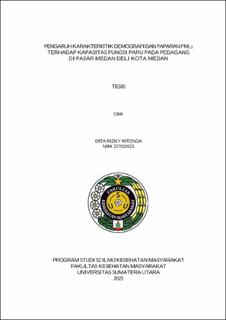| dc.description.abstract | Vendors are among the populations at risk due to continuous exposure to PM2.5. PM2.5 is one of the pollutants emitted from vehicle emissions, referred to as fine particles, and when inhaled into the body, can reach the lower respiratory tract. Prolonged exposure in environments with high pollution levels can lead to impaired lung function capacity. This study aims to analyze the influence of demographic characteristics and PM2.5 exposure on lung function capacity among traders at Medan Deli Market, Medan City. This analytical survey employed a cross-sectional research design. The study population included all traders, with a sample size of 55 individuals. Data were analyzed using univariate, bivariate analysis with the chi-square test at a significance level of p<0.05, and multivariate analysis with multiple linear regression. The findings revealed that 23 (41,8%) out of 55 respondents experienced impaired lung function. Air quality measurements showed the highest PM2.5 concentration at point 2 (56.86 µg/m3) and the lowest at point 3 (29.25 µg/m3) inside the market area. The study indicated significant effects of age, smoking habits, and PM2.5 exposure on traders’ lung function capacity, with smoking being the most dominant factors. It is recommended that local authorities, particularly the Health and Environmental Services Departments, conduct regular PM2.5 air quality monitoring, increase pollutant absorbing plants along Medan Deli Market streets, and raise traders’ awareness of the importance of wearing masks to reduce health risks. | en_US |


